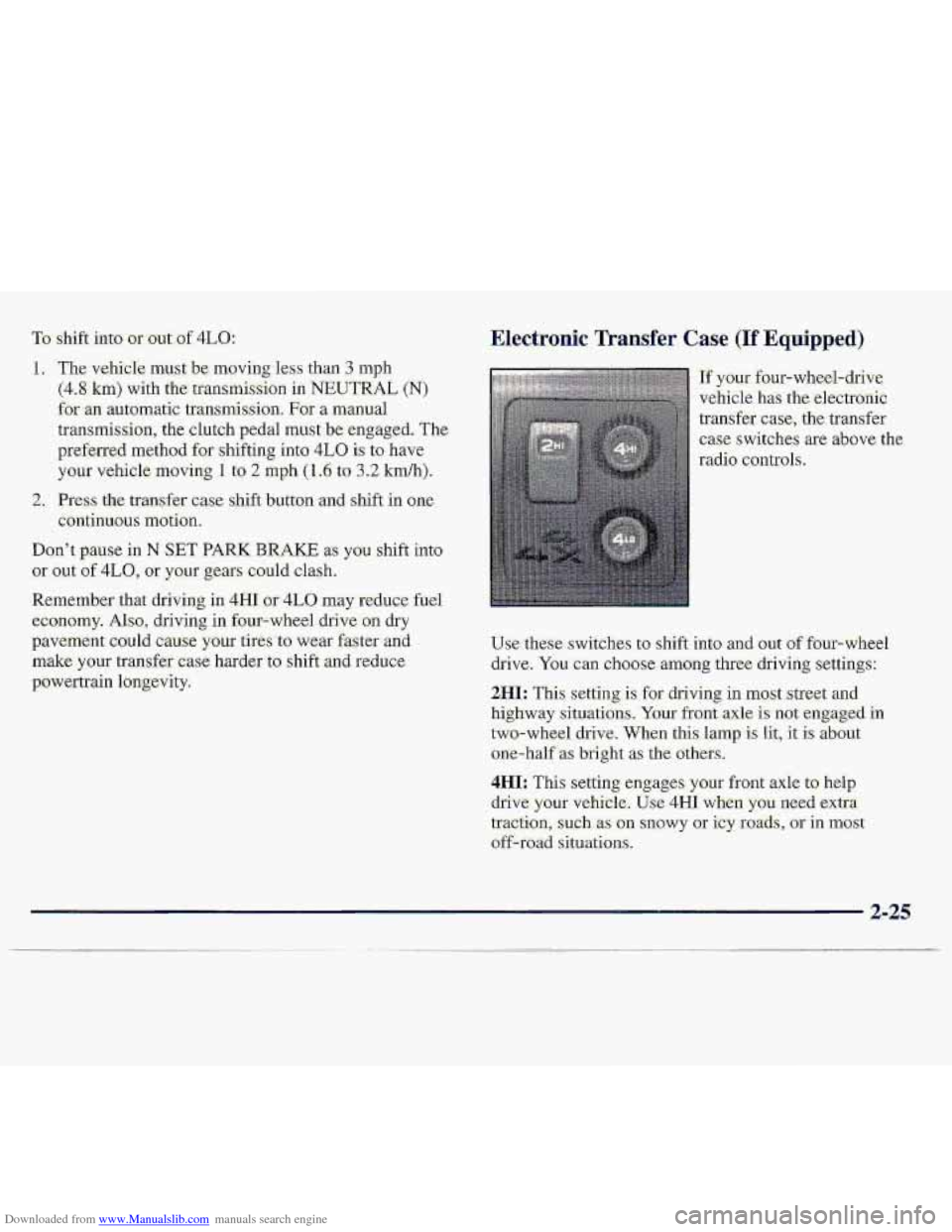Page 69 of 402

Downloaded from www.Manualslib.com manuals search engine When this light CoLmries on, you can shift to the next
higher
gear if weather;-road and, :traffic conditions let
you. Fa; the best fuel economy, accelerate slowly and
-:shift when the light..come,s on..
-Whil.e you accelerate, it is normal for the bght to go ,on
and off -if you quickly change the pwition of the
accelerator. Ignore
the-SHIFT .light when you downshift.
I
If you. skip more I in one gear when you
downshift, you could lose control of your vehicle.
;And y.ou could injure yourself or others. Don't shift
down more than om gear when you downshift.
If your vehicle has four-wheel drive and is equipped
with a
~znanual transmissim, disregard the shift light
when the- transfer
case is in 4LO.
Locking Rear Axle
If you. have this feature, your 1acking.rear axle- can give
you additional tracfim ~n snow, mud," ice, sand or
gravel. It. works like a standard axlemost ofthe the,
but when one
of the rear wheels- has no tractimand the
other
does, this €eatwe will allow the wheel with
traction to move .the vehicle.
Four-wheel Drive (If Equipped)
If your vehicle has. four-wheel drive, you-can send your
engine's dwi.ving power to all four wheels for extra
traction.
To shift QUt of tw-o-wheel drive and into
four-wheel drive, move the transfer case shift lever to
4HI or 4LO. You should use, 2HI-fix.xnost normal
driving conditions.
NOTICE:
~~~~ ~~~ ~~
Driving in the 4HI or 4L.O pusitions for a Icing.
time 0.n dry or wet pavement .could shorten the
life of. your vehicle's drivetrain.
2-22
Page 72 of 402

Downloaded from www.Manualslib.com manuals search engine TO shift into or mt. of 4LQ:
1. The-vehicle myst be movingless than 3 mph
(4.8 h) with the tfansrnissi-on in NEUTRAL (N)
fa an automatic transmisSion. Fm a n~anual.
transmission, the clutch pedal must
.be engaged. The
p-referred method for shi€tin.g into 4LO is to have
your vehicle moving
1 to 2 mph (1.5 to 3.2 Wh).
2. Press the trans€er case s:hi€t buttan .and shift in one
continuous motion.
Don't pausejn
N SET PARIK;BRAKE as y-ou shift into
or out of 4L0, or your gears could clash.
Remember that driving in 4HI ur 4LO may reduce fuel
ec-onomy.
Also, driving in fo.ur-whee1 drive:on dry
pavement could cause your tires to wear faster and
make your transfer case harder to shift and-reduce
powertrain longevity.
Electronic Transfer. Case (KEquipped)
I~y~~~-four-wheel-drive
vehicle
has the electrofiic
transfer
case, the transfer
case switches are above the,
radio controls.
Use these switches to shift into and out of four-wheel
drive.
You can choosea-rmng three driving settings:
2M[: This setting- is for driving in most .street and
highway situatibns ... Your front axle is not engaged in
two-wheel drive. When this. lamp is lit, it is about
orre-half as bright as the Others.
4HI: This setting engages your front axle ta- help
drive,
your vehitk. Use 4Hi when YOU. need extra
traction, such as
on snowy or icy rcmds, or in mast
off-road situations-.
Page 87 of 402
Downloaded from www.Manualslib.com manuals search engine Cruise Control (If Equipped)
-With cruise control, you can
.maintain a speed of about
25 mph (40 km/h) or more
without keeping your foot
on the-accelerator. This can
really help on long trips.
Cruise control does not
work-at speeds belo-w about
25 mph (4.0 kdh).
If you have an automatic transmission and y.0~ apply
your brakes, the cruise control will shut off.
:If you have a manual transmission and you apply your
brakes
or push the clutch pedal, the cruise control will
shut off:
@ Cruise control can be dangerous where you
can’t drive safely aka steady
speed. So,
don’t use your cruise control on winding
roads or in heavy traffic.
slippery
roads. On such roads, fast changes
in
tire traction can cause needless. wheel
spinning, and you could lose control. Don’t
use cruise control on slippery
roads.
a Cruise control can be dangerous on
2-40
Page 164 of 402

Downloaded from www.Manualslib.com manuals search engine Driving in Mnd, Sand, Snow or Ice
When you dxive in mu.d, snow or sarsd, your wheels
won’t get good traction. You can’t accelemte as
quickly, turning i.s more dif€icult, and you’ll need
longer braking distances.
It’s best .to use a low..gear when you’re in mud -- the
,deeper the mud, the lower the gear: In really ,deep mud,
$he idea is to keep your vehicle- moving s.0 you don’t
.!get stuck.
When
you drive on sand, yo-u’ll sensg a change- in wheel
traction, But St will &pmd upon how looseiypacked the
,sand is. On loosely packed sand (as on. beaches or sand
dunes)
your tires will tend to sink into the sand. This has
an effect on steering, accelefating and braking. You may
,w.ant to reduce the air pressure in your tires slightly
when driving on :sand. ‘This. will improve traction,
Hard packed mow ;sad ice. oEer the wofWtire’tractioa.
On thes~e s-Urfac.e.s, it’s very easy to lase c.on!Td, On wet
ice, for example, the traction i.s so paor that you will
h,ave diffic-ulty
accelerating, And if you d:o gkt movi.ng,
poor sleeting and difficult braking- can cause you to slide
out of control.
Driving on frozen lakes, ponds or rivers can be
dangerom. Undewater sprirmgs, currents under
the ice, or
sudden thaws can weaken the ice, Your
vehicle could fall through the ice and you and ,
your passengers could drown. Drive your vehicle
on -safe-surfaces only.